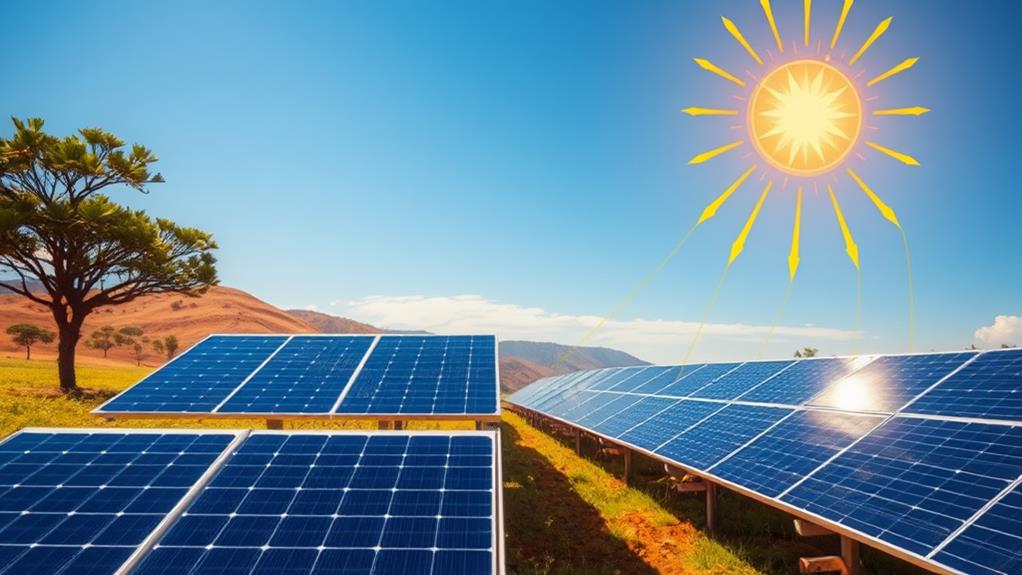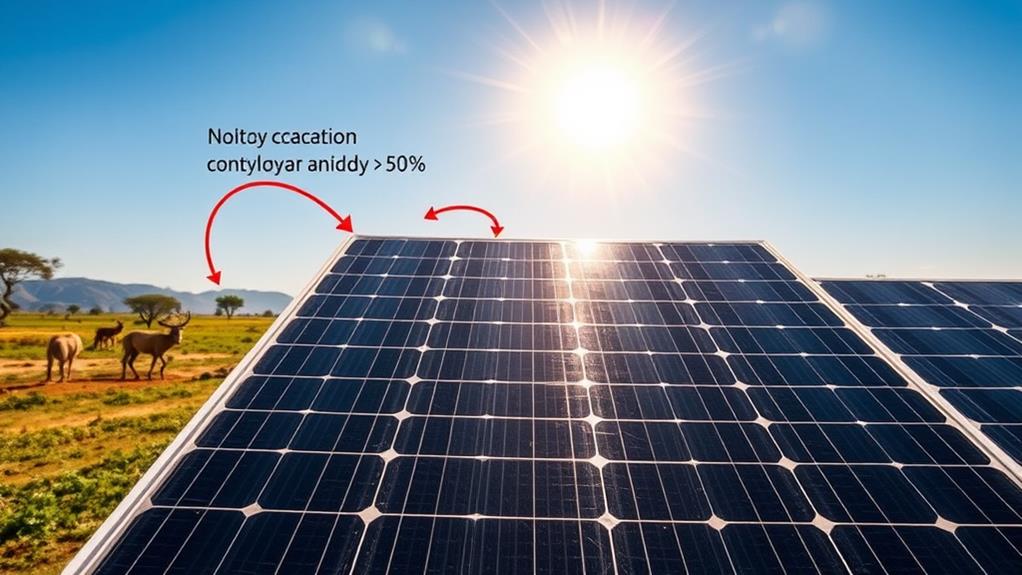Calculating solar panel output in Kenya starts with understanding solar irradiance, which varies across regions. You'll need to determine the peak sun hours (PSH) for your specific location, usually between 4 to 6 hours daily. Next, multiply the wattage of your panels by these PSH to estimate daily energy production. However, it's essential to factor in system losses, like shading and inverter inefficiency, which can reduce output by 14% to 22%. By carefully considering these elements, you can more accurately gauge your solar system's potential. But how do you account for all variables effectively?
Understanding Solar Irradiance

Understanding solar irradiance is essential for calculating solar panel output in Kenya. Solar irradiance measures the power per unit area received from the sun in the form of electromagnetic radiation.
In Kenya, you'll find that solar energy potential is high due to ample sunlight hours, averaging around 5.5 to 6 hours daily. The country's equatorial position provides consistent sunlight throughout the year, making solar energy a sustainable choice for many applications.
To determine solar panel efficiency, you need to quantify the solar irradiance specific to your location. Utilize data from meteorological satellites and ground-based stations, which provide accurate measurements of sunlight hours and irradiance levels.
You'll often encounter values expressed in kilowatt-hours per square meter per day (kWh/m²/day). For precise calculations, integrate these irradiance values with your solar panel's specifications, such as its efficiency rating and surface area.
This data-driven approach guarantees you maximize energy capture and optimize your investment. Kenya's equatorial position affords it consistent solar energy year-round, making it an ideal choice for harnessing solar power.
Assessing Roof Orientation
After quantifying solar irradiance, the next step involves evaluating roof orientation to guarantee ideal solar panel performance.
Begin by examining your roof angles. In Kenya, peak energy capture typically occurs when panels are oriented towards the equator—facing true north. The ideal tilt angle generally matches your latitude, around 1° north to 5° south, to maximize sunlight absorption throughout the year. Confirming this orientation helps maximize energy conversion, contributing to greater efficiency.
Next, conduct a thorough shading analysis. Shading can drastically reduce the efficiency of your solar panels. Evaluate potential obstructions such as trees, neighboring buildings, or even chimneys.
Utilize tools like Solar Pathfinder or digital apps to map out shading patterns across different times of the day and seasons. This analysis aids you in identifying and mitigating shading issues, confirming consistent energy production.
Incorporate precise data points from your findings to adjust roof angles and enhance panel placement. Remember, even minor deviations can greatly impact overall performance.
Calculating Panel Efficiency

Calculating panel efficiency is an essential step in determining the overall performance of your solar energy system. To start, you'll need to understand the specific panel technology you're using. Efficiency is typically measured as the ratio of electrical output (in watts) to the solar energy input (in watts per square meter). For instance, if your panel outputs 250 watts and the solar irradiance is 1,000 watts per square meter, the efficiency would be 25%.
Consider the type of cells in your panels—monocrystalline, polycrystalline, or thin-film—as each has different efficiency rates. Monocrystalline panels generally offer the highest efficiency, often between 15-20%.
However, over time, all panels experience performance degradation. Most panels degrade at about 0.5% per year, so after 20 years, you might see a reduction of around 10%.
To calculate the adjusted efficiency, factor in this degradation rate. For a panel with an initial efficiency of 20%, after 10 years, the efficiency might drop to around 19%. This degradation impacts the long-term yield of your system, so account for it in your performance evaluations.
Additionally, consider choosing the right inverter to guarantee peak system performance and energy sustainability. By understanding these factors, you can make informed decisions to maximize your energy independence.
Estimating Daily Output
With the panel efficiency now in hand, you can move on to estimating the daily output of your solar panels in Kenya.
Start by understanding the peak sun hours (PSH) specific to your location. In Kenya, this typically ranges from 4 to 6 hours per day. PSH represents the time when solar irradiance averages 1,000 watts per square meter.
By considering the advanced technologies that enhance efficiency in energy conversion, you can better gauge the output potential.
To estimate the daily output, multiply the panel's wattage by the PSH. For instance, a 300-watt panel with 5 PSH results in 1,500 watt-hours or 1.5 kilowatt-hours (kWh) per day. This calculation helps determine solar panel sizing based on your energy consumption needs.
Next, assess your household or business's daily energy consumption in kWh. If your daily usage is 10 kWh, you'd need around seven 300-watt panels (10 kWh / 1.5 kWh per panel ≈ 7 panels).
Confirm your system's size aligns with your energy consumption to guarantee peak performance and energy independence.
Factoring in System Losses

System losses are an unavoidable aspect of solar panel installations, and it's vital to factor these in to get an accurate estimation of your system's output. Losses can stem from various sources such as shading, soiling, wiring, and inverter inefficiencies. Typically, system losses can account for about 14% to 22% of the total energy conversion, greatly impacting overall system performance.
Many off-grid solutions are designed to be more reliable than traditional methods, making renewable power a viable option. First, consider shading. Even partial shading can drastically reduce output, so make sure panels are installed in an area with minimal obstructions.
Next, soiling from dust or bird droppings can lower efficiency. Regular cleaning is vital to mitigate this. Wiring losses occur due to resistance in cables, so opt for high-quality, appropriately sized wires to minimize this issue.
Inverter losses are another significant factor. Inverters convert direct current (DC) from panels to alternating current (AC) for home use, but this process isn't 100% efficient. Modern inverters typically achieve around 95% efficiency, which should be factored into your calculations.
Conclusion
To summarize, calculating solar panel output in Kenya involves understanding solar irradiance, evaluating roof orientation, and calculating panel efficiency. Estimating daily output by considering peak sun hours, and then factoring in system losses, will give you a more precise figure. Remember, every kilowatt counts! By following these steps, you'll optimize your solar investment and harness the sun's power more effectively—turning sunlight into savings.
